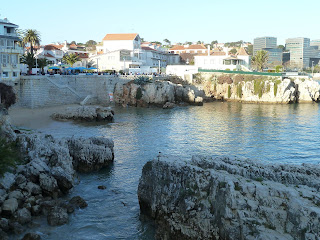Cascais is a town located to the west of Lisbon, along the coast. It's about a 45 minute commuter train ride away, and by the time you get out there you're no longer seeing the Tagus river - it's all Atlantic Ocean. Cascais and Estoril (next door just to the east of Cascais) are known as beach towns, but also for hosting the homes of Lisbon's wealthiest citizens (and the resorts of Portugal's wealthiest tourists). The center of town itself doesn't really give you that feeling, but it's in the details. The restaurants are all pricy, the cars are all very expensive, most people walking around are dressed nattily, etc. Amidst all this, Cascais still hosts a small fishing fleet, who's harbor is around the corner from a large, fancy marina.
Here's one of the trains one takes to get to Cascais. They leave from Cais do Sodre station, which is a short walk from our apartment.
The actual beaches within Cascais are pretty small. The really nice beaches are outside of town, and you pretty much need a car or bicycle to get to them. This shows Praia Pescadores, the busiest beach within Cascais, as it is the most centrally located.
This beach is known as "Praia Pescadores" (which translates to Fishermen's Beach) because it hosts the small-time fishing industry. Following along to the left, past the palm trees there is a former fort which has been turned into a luxury hotel & conference center, and past that is the marina (you can barely see the masts of the sail boats).
Here's a view back into town from the vantage point of those homes we were looking at in the previous two pictures. This statue is Cascais' version of the Monument to the Discoveries, which commemorates Portugal's early sea-faring heritage.
Here's a more unimpeded view.
Along the street up the hill were several nice, big houses looking out at the beach. I though this one was very unique and beautiful, so I took its picture.
As you go past the previously pictured fort and marina, you follow along the water westward towards the coast where it turns north-south. Near that corner is the "Boca do Inferno", which translates to Mouth of Hell. It's an area where the shore is made of jagged and uneven rocks. Because of this and the strength of the tides, it's known for having spectacular waves that crash into the rocks and create huge sprays and echoing booms. Along the way you pass an estate that belonged to the Condes Castro Guimarães, a line of Counts (Condes). The land and mansion have since been returned to the state (I don't know if the transer was voluntary or coerced) and made into a museum and public park.
Here's a funky little restaurant hanging on the rocks, followed by the Santa Marta lighthouse, which doesn't really function anymore and is now surrounded by, what else, a luxury hotel.
Here are a variety of pictures of the Boca do Inferno area. There were some brave souls out along the edge fishing. I wasn't able to capture the biggest and flashiest sprays. It was unpredictable and hard to guess when they would appear, so I took what I could and then just enjoyed being there.
Turning our attention back towards the Condes Castro Guimarães, here is their mansion as viewed from the road.
Here's the main entrance:
A fountain tiled with azulejos, just to the right of the main entry we just saw.
A close-up of the tower.
They had some neat things on display inside, but we didn't have time to see everything since we arrived only ten minutes before it closed.
This was the interior courtyard.
I guess the four-leaf clover featured prominently in the crest of the Condes Castro Guimarães. It was a design motif in several places, most prominently in the ceiling of this room.
This ceiling, in another room, was really impressive. Those are several different crests set into the ceiling. Because of the time crunch, we didn't have time to find out more about them (I would guess they're either crests of Portuguese royal families, or of various royal familes that had ties to the Condes Castro Guimarães).
Check out this organ! It would be cool to hear it played. I bet it got loud in that room.
Finally, here is a cabinet with some beautiful inlayed woodwork. That central image was really finely detailed.
Cascais: a beautiful and relaxing side trip.
























Beautiful pictures. Surprised by the graffiti on the train. The cacti-type plant in front of the quirky restaurant... was that part of the plant at it's base? It looks like it was painted gold, or was that a rock?
ReplyDeleteAnother set of interesting pictures. Next time down there, try the Pacific Ocean wave counting method to see if it works on the Atlantic - every 7th wave is going to be big, and the 49th is usually the biggest of the series...
ReplyDeletePacOcenBoi
The shamrocks are there because the house was built by to The O'Neill of Clandeboye, head of one of Ireland's great families and heir of Hugo O Neill who fled Ireland 400 years ago!
ReplyDelete